|
|
Post by kel on Dec 26, 2019 23:09:34 GMT -5
1/3 fake ?
|
|
|
|
Post by Shadow on Dec 28, 2019 20:56:17 GMT -5
Hmmm, are you sure?  Two Soqotri Islanders |
|
|
|
Post by Ish Gebor on Feb 17, 2020 10:09:20 GMT -5
This is something that I wanted to show to people for quite a while now.  This is a depiction of three Chaldean soldiers with Hebrew captives, from a Byzantine illuminated manuscript called the Bristol Psalter, circa 11th century 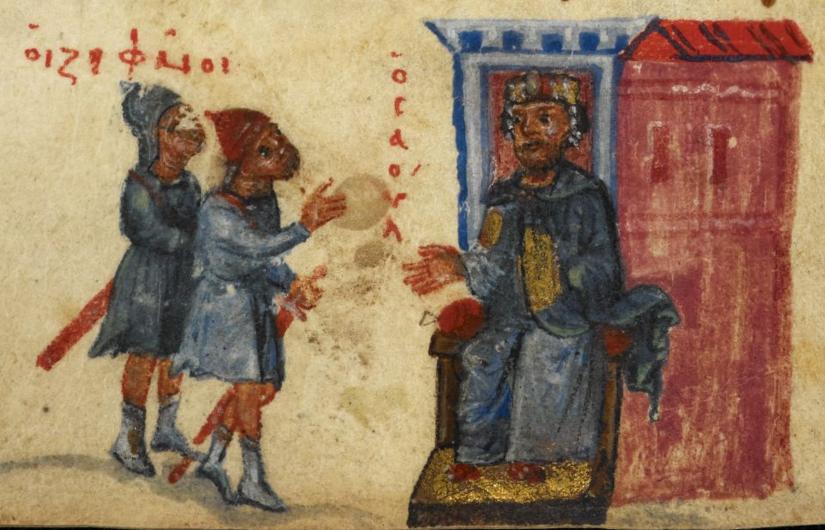 Two Ziphites before Biblical character King Saul, from manuscript  A depiction of Biblical character David slaying the Philistine giant Goliath  David cutting off the head of Goliath  Another depiction of King David in some sort of pose  David being crowned King of Israel  A depiction of King David with a group of musicians 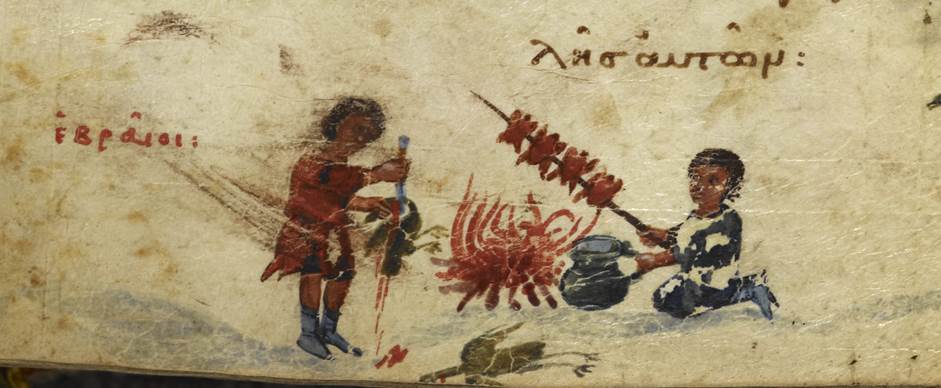 A depiction of two Hebrews planning dinner  The Prophet Isaiah in prayer accompanied by the personifications of Night and Dawn 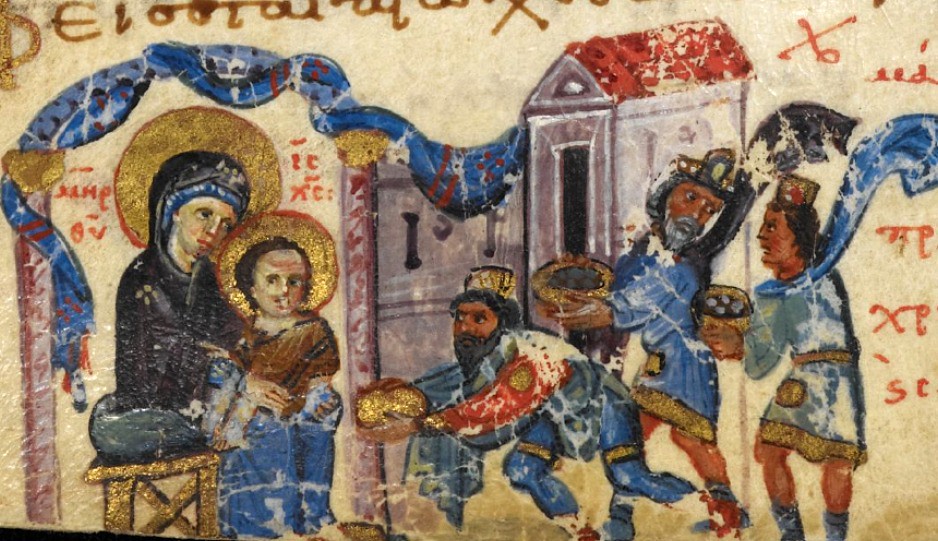 The Magi delivering gifts to baby Christ 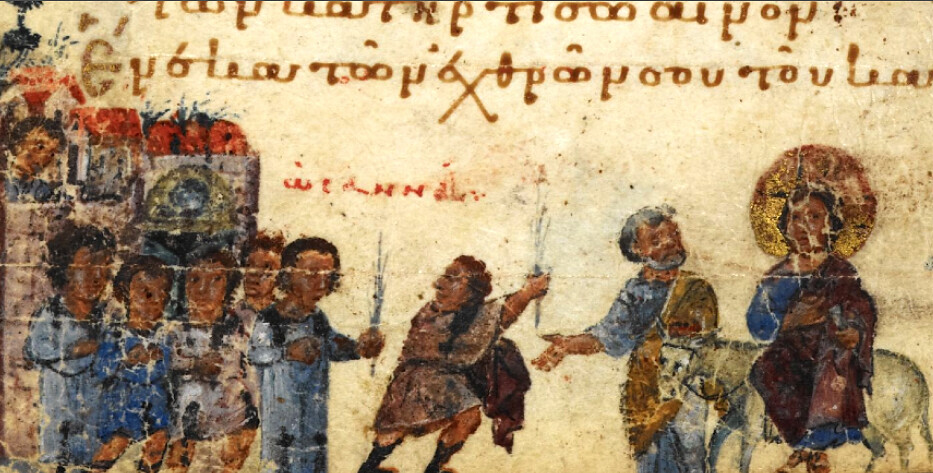 A depiction of Christ with his Disciples and their entry into the gates of Jerusalem  Another depiction of King David kneeling to the Prophet Nathan, as he delivers a message to him  A depiction of of a beggar in misery |
|
|
|
Post by Tukuler al~Takruri on Feb 22, 2020 13:09:00 GMT -5
Sir, you are to be commended for this stupendous assembly!
|
|
|
|
Post by kemetic on Apr 16, 2020 10:18:41 GMT -5
I had some mixed feelings about the Etruscans, until I did my research about their origins. Apparently they mostly indigenous to the Italian Peninsula, but with significant Aegean (Anatolian) ancestry, which explains images such as these....  Aristocratic Male Figure from the Tomb of Necropolis in Paestum, Campania, Italy  Tomb of the diver, from the same site 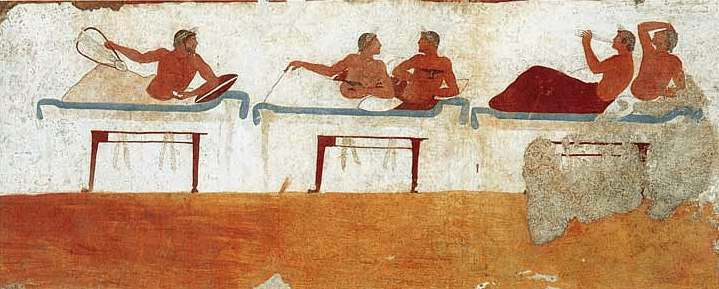 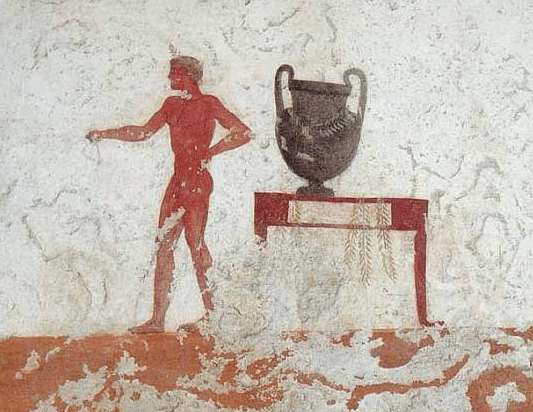 Dark complexioned Etruscan men, from the Tomb  A fresco of dark complexioned Boxers, from a Lucan tomb, Basilicata, Italy It’s interesting to see images such as these in pre Roman Italy, especially since these images are in the heartland of the entire “Mediterranean” world. These paintings reflect the racial diversity of their part of the world and contradicts Mediterranean racialists notions! These frescoes are just a couple years older than the Roman Republic, it wouldn’t be surprising to see remnants of these populations present during the height of the Roman Empire! Speaking of which here are frescoes from the height of the Roman Empire in the 1st century CE. 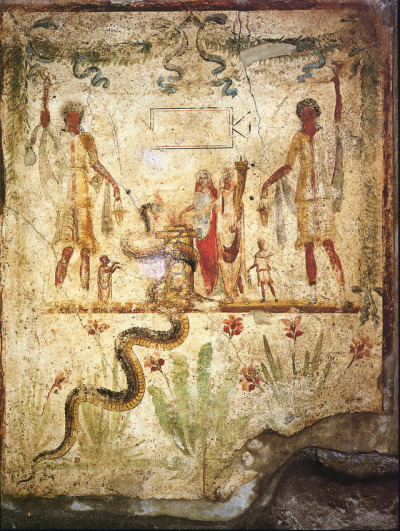 A Roman fresco depicting Priests making an ancestral sacrifice at an alter, from house altar/lararium, House of Julius Polybius, Pompeii  A Roman fresco depicting a Genius making a sacrifice at an altar while two Lares stand on either side, from the same city Note that in both frescoes, the individuals are portrayed with a reddish brown complexion, especially the fresco Number one thing we as Afrocentric people need not do anymore is take ancient artworks and assume the racial make up based on the skin tone alone. I've seen various skin tones depicted in European artwork, some of them obviously referring to the tanner individuals of their population and not people of a different racial background. Just by some of the clothing choices alone with some being quite minimum in many of the artworks, there a much higher chance that these people were darker simply due to more sun exposure. I can easily imagine many people of the Mediterranean world having more of a Bedouin-like skin tone in ancient days. Also, some of the color choices could be purely stylistic. |
|
|
|
Post by Shadow on Apr 18, 2020 17:51:16 GMT -5
This is up to interpretation, as the images that I previously posted are quite frankly striking. Generally speaking, I do agree that there should be limitations over selections of images that are conventional rather than realistic. I myself, have attempted to make discretion over images that I chosen for this thread, so that I did not make the mistake of misinterpreting the art. Though, I still think that the images that I have chosen could have realistically reflected the heterogeneity of the population, but this has remain unproven. If this was to be the case that these populations were mixed, which is supported by genetic research of these people, then there should be a context of viewing these depictions of Ancient populations, like the Etruscans. For me, I tend to based these images as reflection of Middle Eastern influences and some partial African influences.
|
|
|
|
Post by kemetic on Apr 19, 2020 10:48:41 GMT -5
This is up to interpretation, as the images that I previously posted are quite frankly striking. Generally speaking, I do agree that there should be limitations over selections of images that are conventional rather than realistic. I myself, have attempted to make discretion over images that I chosen for this thread, so that I did not make the mistake of misinterpreting the art. Though, I still think that the images that I have chosen could have realistically reflected the heterogeneity of the population, but this has remain unproven. If this was to be the case that these populations were mixed, which is supported by genetic research of these people, then there should be a context of viewing these depictions of Ancient populations, like the Etruscans. For me, I tend to based these images as reflection of Middle Eastern influences and some partial African influences. Here the issue though. The many black people who are just beginning their research into African/black history are stumbling upon hundreds of afrocentric sites using imagery or shallow descriptions of people to claim people as blacks. When I first began my journey into black history, I was falsey lead by many sites and books into viewing certain civilizations around the world as “black”. I did not think these sites were lying to me. It was very easy to believe that due to racism, the only reason it not acknowledge that certain people were black was due to an elaborate racist cover-up. It took a long time for me to discern between what actually true and what is just a bunch of malarkey- and a good percentage of it was a bunch of malarkey. People would take descriptions such as a person being dark skin with a broad nose and use that as all of the evidence they need of a person “blackness” or partial blackness without giving any thought to what that could of meant in context of that period. It annoyed me greatly when I was lead to believe that “this well know person and this person were blacks” only to find after further research that that was bull. Using these artistic depictions is another common tactic. None of the pics you displayed look black in any shape of the imagination. These are obviously non-african people… but back than when I was starting my journey I would definitely have agreed and been like “yep, blacks” and ignored the truth that was clearly in front of me. For example, that royal guards of Darius. Sure, the paint for the skin tone is darker, but look at these men. Look at the full beards and hair of the men. Many civilizations of the Mediterranean were big on growing long beards and hair. Many of them do so to this day. You know what people weren’t big on that? African people! From the west african coasts to the horn of africa, your not going to find a population of black people who regularly wore long full beards like this(it also much more harder for us to grow long beards like that). These people depicted don’t look like black Africans. The reasons why the artist chose to depict them with dark brown skin could be for a multitudes of reasons, reasons that would make much more sense than “these people were black.” I wouldn’t call any of the people depicted in that Roman fresco black either. Look at the clothing, the hair texture, hell even the skin tone depicted isn’t black african. It a pretty obvious tan coloring depicted there. Yet your trying to give the argument that these artworks are evidence of African influence. It not in any way, shape, or form. Thinking like this is what is leading many ADOS blacks into claiming being the real Native Americans. This is why we have to put a stop to this frame of mind. We got to do better as people in terms of evidence. We have to do a lot more embracing of the civilizations in West, Central, East, and South of Africa and make that more appealing for our people and less on China, India, Middle East, and whatever else we would sometimes claim based on scant evidence. |
|
|
|
Post by Shadow on Apr 23, 2020 16:41:30 GMT -5
Here the issue though. The many black people who are just beginning their research into African/black history are stumbling upon hundreds of afrocentric sites using imagery or shallow descriptions of people to claim people as blacks. When I first began my journey into black history, I was falsey lead by many sites and books into viewing certain civilizations around the world as “black”. I did not think these sites were lying to me. It was very easy to believe that due to racism, the only reason it not acknowledge that certain people were black was due to an elaborate racist cover-up. It took a long time for me to discern between what actually true and what is just a bunch of malarkey- and a good percentage of it was a bunch of malarkey. Look, I get that you have been conflicted with faulty sources concerning “Black” history, so it may leave people such as yourself critical over information people may put out there online. I too, had to duck and dodge some information that was pseudo and not credible enough to be true, so I understand where your coming from. Despite this frustration, I was still able to find some information that was verified by credible sources, even though some of the claims sounded too real to be true. This helped enforce some validity to some of the claims various people were putting out there, regardless of it was exaggerated. The best advice that I can give someone who is not convinced over information that is out there, is to research that information over and over again. This alone can establish to some extent that authenticity of that information.
People would take descriptions such as a person being dark skin with a broad nose and use that as all of the evidence they need of a person “blackness” or partial blackness without giving any thought to what that could of meant in context of that period. It annoyed me greatly when I was lead to believe that “this well know person and this person were blacks” only to find after further research that that was bull. Using these artistic depictions is another common tactic. None of the pics you displayed look black in any shape of the imagination. These are obviously non-african people… but back than when I was starting my journey I would definitely have agreed and been like “yep, blacks” and ignored the truth that was clearly in front of me. For example, that royal guards of Darius. Sure, the paint for the skin tone is darker, but look at these men. Look at the full beards and hair of the men. Many civilizations of the Mediterranean were big on growing long beards and hair. Many of them do so to this day. You know what people weren’t big on that? African people! From the west african coasts to the horn of africa, your not going to find a population of black people who regularly wore long full beards like this(it also much more harder for us to grow long beards like that). These people depicted don’t look like black Africans. The reasons why the artist chose to depict them with dark brown skin could be for a multitudes of reasons, reasons that would make much more sense than “these people were black.” I feel that you didn’t get the point of this thread. The point of me creating this thread was not to present a collage depictions of populations of recent African descent, but rather Ancient dark skinned populations that were once prevalent in the Middle East than they are now! This thread was meant to show a context to the various claims of various people, who for the most part are lumped into the bubble category of “Afrocentric”, regardless if they directly identify with Africa, but however spout what seems to be radicalized exaggerated revisionism concerning the appearance of some Ancient populations of the Middle East. Your point about People taking descriptions and depictions of Ancient populations again reinforces what I maintained in my previous response to you, a interpretation! People regardless of their group preferences, will always have their own opinions about everything that pertains to the meaning of a document or art. This in itself is not surprising, as people who happens to come across something like a quote detailing someone with say dark skin and distinct features will likely assume to reflect this so or so population, while others will see the quote as reflecting this so or so population, thus beginning an exhausting battle between determining the right point of view of the description. This is what I suspect in these discussions regarding “race“ and “ethnicity”. There’s have to be a right interpretation to the description, right? So, if I as a person with a “Afrocentric” perspective believe that my interpretation of the quote is correct, I would want to have all of the verifiable proof to swiftly debunk and disregard any evidence the person is providing as a counter argument. This small analogy fits accurately to what most people online debating about the identity of said are generally doing. This thread, although not as verifiable as it seems, is a good source when it comes to online debates about the appearance of certain groups. It is particularly something amateur historians generally find helpful, so it clearly seems to be somewhat a multidisciplinary approach to what people seem to have about what some populations in the Middle East looked like, even if it just thread about images. Your point about there not being a cultural commonality between these populations and Africans, especially regarding facial hair not being common among African societies is moot! Also, it’s funny how you are generalizing African populations, when there is a wide range of diversity concerning language, customs, and above all hair!

Djenné-Djenno statuette of bearded Man (Mali, West Africa)

The painting of Abuna Yemata Guh church (Ethiopia, East Africa)
“From West to East”
Also, in regards to your comment about the selective images that I chose for this thread, not depicting “Black” people, that depends on your definition of a “Black” person. Look, i’m not going to argue with you on the concept of “Blackness”, because I think you already know that everyone has their own little definition of what a “Black” person is. However, this thread was to show a variety of Ancient depictions of Middle Easterners that most people, including myself, would consider to be in the category of a “Black” person, regardless if they don’t go with your definition of “Black”! I mean, according to you, they have to be jet Black in order to fit some people’s definition of “Black” and be of recent African descent, even though, all “Black” are not extremely dark and varied from a wide range of complexions according to again many people’s definition of “Black”! This would defeat the whole purpose of this thread! And what multitude of evidence is there to suggest that these populations weren’t dark brown? Clearly your kidding? Have you taken a look at some populations in the Middle East today, it’s only a handful that would fit the right complexion to these images and those are the Middle Easterners that are out of the norm of people of the Middle East!
 Soqotri Islander Soqotri IslanderI wouldn’t call any of the people depicted in that Roman fresco black either. Look at the clothing, the hair texture, hell even the skin tone depicted isn’t black african. It a pretty obvious tan coloring depicted there. Yet your trying to give the argument that these artworks are evidence of African influence. It not in any way, shape, or form. Thinking like this is what is leading many ADOS blacks into claiming being the real Native Americans. Funny that you said that, because I was careful enough to present these selected frescoes of these Etruscans as nothing else than reflecting the heterogeneity of the entire population in general. I made no serious attempt to make the Etruscans as “Black” people, but a population that had “Black” amongst them, particularly from the Aegean. Again, your point in noting the clothing of the selected images means nothing as I previously said that these people would represent a mixed European/Eastern Mediterranean originated population and not entirely a African population! I have made no attempt to present any of my selected images as Africans, at all! Also, the “they were tan” explanation has little validity when it comes to these images, especially since I can’t find any clear evidence that the art represents tanning in a salon. Come on now, this logic is constantly used on the Egyptians. You could make the argument that this represent a color convention of some sort, but that’s about it. Also, don’t know why you think that “Black” Africans don’t have ruddy skin tones....
 Sudanese childrenBy the way, the whole scenario concerning “Black” Native Americans does need a a lot of context! All of which both many advocates of the idea that “Blacks” were present in the Americas before the Europeans and opponents of the idea has failed to do! I seen some few examples of this thing put into it’s context, however most of the examples I saw was very amateurish! Maybe, I should attempt to explain this hold scenario in another thread someday in the near future. Oh well. Sudanese childrenBy the way, the whole scenario concerning “Black” Native Americans does need a a lot of context! All of which both many advocates of the idea that “Blacks” were present in the Americas before the Europeans and opponents of the idea has failed to do! I seen some few examples of this thing put into it’s context, however most of the examples I saw was very amateurish! Maybe, I should attempt to explain this hold scenario in another thread someday in the near future. Oh well.

Californian NativesThis is why we have to put a stop to this frame of mind. To be frank, no one really has to stop using pictures as an example to prove their point. Again, it boils down to interpreting the art people you are presenting as evidence, all of which I was cautious in doing!We got to do better as people in terms of evidence. And that’s fine, but this thread is not necessarily about presenting peer reviewed studies about the genetic heritage of the Middle East, it’s more a collage of images portraying Middle Easterners. Perhaps I could make a thread concerning this, once I got time on my hands.We have to do a lot more embracing of the civilizations in West, Central, East, and South of Africa and make that more appealing for our people and less on China, India, Middle East, and whatever else we would sometimes claim based on scant evidence.
Umm yeah, I don’t buy into this idea that there’s an epidemic of Black people embracing non-African cultures, instead of their own cultural heritage. That’s a crowd of bullshit that White Supremacists and their little non-White ass kissers spout to try to degrade Black people, particularly Black Americans, for just saying the Egyptians were Black, nothing else. Any other examples of Black people claiming another “heritage” other than the Egyptians, like the Berbers and Jews are the what Black people are generally focused on. The Egyptians I agree, Black people should focused on a little less, but that’s generally not going to happen any time soon because of the whole frustration over making them non-Black, so yeah. Any other example of Black people allegedly being interested in non-African heritage are not really that much appealing. Like, how many times you see people of African descent claim that the first Chinese dynasties were Black or embrace India, and above all Sumer compared with the Egyptians, Nubians, Ethiopians, Berbers, Mandinka, Igbo, Ashanti, and the Yoruba, probably not a lot. All of this is mainly just taking pride in a cross-continental presence around the World, there’s not really much interest in embracing Chinese heritage, unless your connecting them to the Egyptians, Nubians, and even some other African or Black population. Just none!
|
|